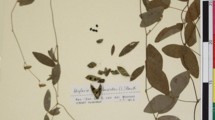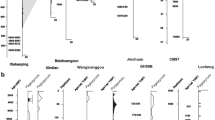Abstract
Previous suggestions that prehistoric agriculturalists of the Ozark Bluff Dweller culture utilized a fully domesticated form ofChenopodium have been confirmed. Comparative examination of infructescence and fruit structure indicates that archaeological material is assignable toC. berlandieri ssp.nuttalliae, a product of Mexican agriculture. Large-fruited chenopod remains from other sites in eastern North America, often identified as those of wild species, may also belong to the Mexican domesticated form. A related, wild species of northeastern North America,C. bushianum, shows similarities to the Mexican weed-crop complex that may reflect prehistoric genetic interaction. This is the first documented report of domesticatedChenopodium from prehistoric North America.
Similar content being viewed by others
Literature Cited
Aellen, P., and T. Just. 1943. Key and synopsis of the American species of the genusChenopodium L. Amer. Midl. Naturalist 30: 47–67.
Asch, D. L., and N. B. Asch. 1977. Chenopod as cultigen: a reevaluation of some prehistoric collections from eastern North America. Mid-continental J. Archaeol. 2: 3–45.
Chomko, S. A. and G. W. Crawford. 1978. Plant husbandry in prehistoric eastern North America: new evidence for its development. Amer. Antiquity 43: 405–408.
Gandarillas, H. 1968. Estudios de herencia de la quinua. Inst. Boliviano de Cultivos Andinos, Minist. Agric. Bol. Exp. 35.
Gilmore, M. R. 1931. Vegetal remains of the Ozark Bluff Dwellers culture. Pap. Michigan Acad. Sci. 14: 83–103.
Harlan, J. R. 1965. The possible role of weed races in the evolution of cultivated plants. Euphytica 14: 177–188.
Hunziker, A. T. 1952. Los pseudocereales de la agricultura indigena de America. Mus. Bot. Cordoba Publ. Misc. No. 3.
Karssen, C. M. 1970. The light promoted germination of the seeds ofChenopodium album L. III. Effect of the photoperiod during growth and development of the plants on the dormancy of the produced seeds. Acta Bot. Neerl. 19: 81–94.
Pickersgill, B. 1977. Taxonomy and the origin and evolution of cultivated plants in the world. Nature 268: 591–595.
Rydberg, P. A. 1924. Plants used by ancient American Indians. J. New York Bot. Gard. 24: 204–206.
Wahl, H. A. 1952–53. A preliminary study of the genusChenopodium in North America. Bartonia 27: 1–46.
Wilson, H. D. 1980. Artificial hybridization among species ofChenopodium sectionChenopodium. Syst. Bot. 5: 253–263.
—, and C. B. Heiser. 1979. The origin and evolutionary relationships of ‘huauzontle’ (Chenopodium nuttalliae Safford), domesticated chenopod of Mexico. Amer. J. Bot. 66: 198–206.
Winton, A. L. 1932. The Structure and Composition of Foods, pp. 322–325. Wiley, New York.
Author information
Authors and Affiliations
Rights and permissions
About this article
Cite this article
Wilson, H.D. DomesticatedChenopodium of the Ozark Bluff Dwellers. Econ Bot 35, 233–239 (1981). https://doi.org/10.1007/BF02858690
Received:
Accepted:
Issue Date:
DOI: https://doi.org/10.1007/BF02858690




